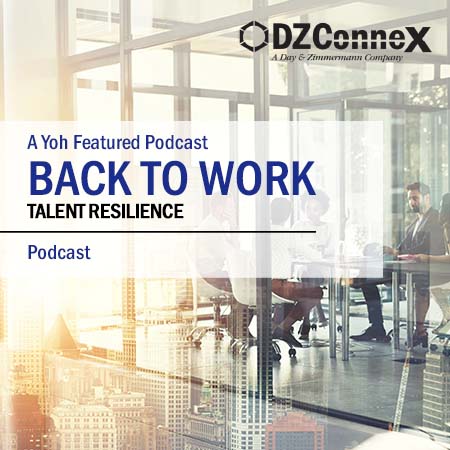No industry is immune from the mass exodus of workers that have been quitting their jobs and leaving the workforce over the past few years. In December 2021, nearly 3% of workers (or 4.3 million Americans) quit their jobs. This leaves companies with many open positions and not enough people to fill them, which is forcing leaders in the talent industry to re-evaluate their hiring and retention strategies.
In this episode of our Back to Work podcast series, Yoh's Vice President of Marketing and Communications, Matt Rivera, talks to host, Joe McIntyre, about the importance of talent resilience in today's work environment. They discuss how TA and HR leaders can practice talent resilience to recruit and retain the right talent in these trying times.
Listen to the full podcast below:
The Talent Exodus
With so many open positions across every industry today, people are leaving their jobs in search of better opportunities. Candidates know that they can be selective in their job search now and be more demanding about what they want from their employer. This is why companies need to practice flexibility. They must try to accommodate candidates needs on an individual basis in terms of remote work, PTO, benefits, work environment, etc. Company leaders should also be checking in with their current employees to see what they can offer to ensure they stay with their organization.
Matt and Joe discuss how hiring managers should be more flexible about who they hire. Before the pandemic, many hiring managers would create 'the perfect candidate' for an open position, and they would search for someone that meets all of this criteria. This highly selective process is no longer efficient, and hiring managers need to re-evaluate their ideal candidate pools. Matt explains how hiring managers should be looking for candidates with impressive soft skills who can be taught how to perform and excel in a position. Hiring for potential will broaden companies' talent pools and eliminate the stress of having too many unfilled positions.
They also discuss the importance of conducting a talent deficit analysis. Companies need to look at how much talent is coming into their organization and how much talent is leaving. They also need to analyze how many open positions they have and create a plan detailing how they can bridge the talent gap to set their organization up for future success.
What Is Talent Resilience?
Simply put, talent resilience is the ability to hire talent when you need to. It's building the resources, partnerships, and processes that are necessary to ensure you can get the talent that you need whenever that need arises. Hiring managers need to plan ahead so they can easily hire the right talent as soon as the demand occurs — and this readiness requires resilience. Although hiring and retaining talent is more challenging than ever before, companies can use this as an opportunity to create new talent acquisition and management strategies that are more effective in helping them achieve their goals.
Encouraging Resilience in Your Organization
An essential part of practicing talent resilience in today's market is motivating your employees to be resilient on their own, and this starts with open communication. If employers show their workers that they have their best interest in mind and truly value them, they will be willing to stay at their job. Don't risk losing your top performing employees because you're not asking them how you can adapt to their needs and build resilience with them.
Based on what your employees' needs are, you might consider recreating the workplace into an environment that promotes employee growth. In these challenging times, a company can only be as resilient as the individuals who make up their workforce.
It's evident that organizations can't rely on a single thing to optimize their hiring and retention efforts. Company leaders need to cultivate multiple resources, hire and recognize potential, stay ahead of their needs with a talent deficit analysis, and talk to their hiring managers to see what gaps they need to fill and look ahead to fix them.
To listen to the full podcast, visit our Podcast Library.







